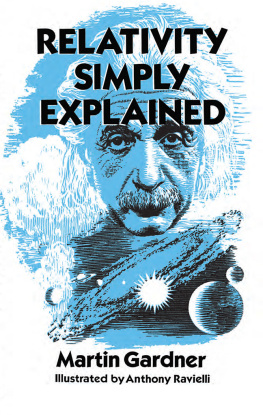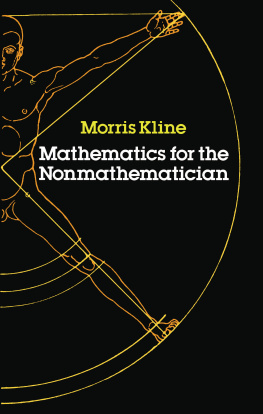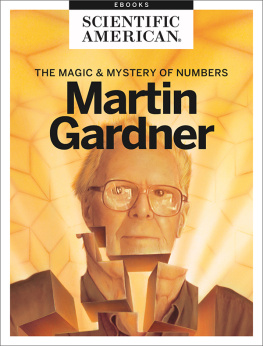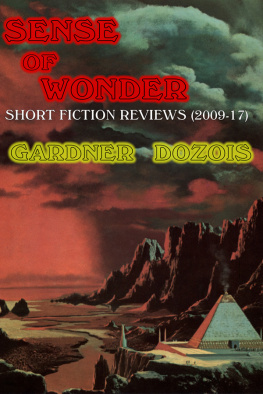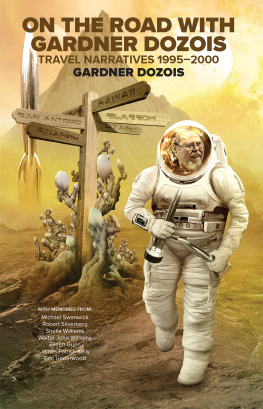ALSO BY MARTIN GARDNER
Gardners Whys & Wherefores
Order and Surprise
The New Age: Notes of a Fringe Watcher
Weird Water and Fuzzy Logic:
More Notes of a Fringe Watcher
On the Wild Side
Science: Good, Bad, and Bogus
Great Essays in Science
The Magic Numbers of Dr. Matrix
How Not to Test a Psychic:
Ten Years of Remarkable Experiments with
Renowned Clairvoyant Pavel Stepanek
The Healing Revelations of Mary Baker Eddy:
The Rise and Fall of Christian Science
The Wreck of the Titanic Foretold?
Urantia: The Great Cult Mystery
The Snark Puzzle Book
The No-Sided Professor
MARTINM
GARDNER
on science, literature, and religion
Fromthe
WANDERING JEW
to
WILLIAM F.
BUCKLEY JR.

Published 2000 by Prometheus Books
From the Wandering Jew to William F. Buckley Jr,: On Science, Literature, and Religion. Copyright 2000 by Martin Gardner. All rights reserved. No part of this publication may be reproduced, stored in a retrieval system, or transmitted in any form or by any means, digital, electronic, mechanical, photocopying, recording, or otherwise, or conveyed via the Internet or a Web site without prior written permission of the publisher, except in the case of brief quotations embodied in critical articles and reviews.
Inquiries should be addressed to
Prometheus Books
59 John Glenn Drive
Amherst, New York 14228-2197
VOICE: 716-691-0133, ext. 207
FAX: 716-564-2711
WWW.PROMETHEUSBOOKS.COM
04 03 02 01 00 5 4 3 2 1
Library of Congress Cataloging-in-Publication Data
Gardner, Martin, 1914
From the wandering Jew to William F. Buckley Jr. : on science,
literature, and religion / Martin Gardner.
p. cm.
ISBN 1-57392-852-6 (alk. paper)
eISBN : 9781615929344
I. Title.
ACS .G333 2000
081-dc21
00-055277
CIP
Printed in the United States of America on acid-free paper
Table of Contents
INTRODUCTION
F rom time to time, when the impulse seizes me, I sound off about topics of interest to me, and respond to requests for book reviews if I think I have something significant to say about a book. The columns I wrote about mathematics for Scientific American are gathered in fifteen books. Five Prometheus books are collections of columns about science and pseudoscience that I have been contributing for many years to the Skeptical Inquirer. Essays and reviews that fall outside those two categories have been put into three books: Order and Surprise, Gardners Whys &l Wherefores, and The Night Is Large. This is the fourth such collection.
As you will see, the topics of this rambling anthology are mainly attacks on bogus science and what I regard as religious superstition. Two reviews are of books about Lewis Carroll, one is about a forgotten childrens magazine, two are attacks on antirealist philosophies of mathematics, and one is a collection of introductions to three books by H. G. Wells.
The long essay on Hugo Gernsback, whose magazine Science and Invention was one of the great delights of my boyhood, is published here for the first time.
Martin Gardner
PART 1
ESSAYS
THE WANDERING JEW
AND THE
SECOND COMING
For the son of man shall come in the glory of his Father with his angels; and then he shall reward every man according to his works. Verily I say unto you, There be some standing here, which shall not taste of death, till they see the Son of man coming in his kingdom.
Matthew 16: 27, 28
T he statement of Jesus quoted above from Matthew, and repeated in similar words by Mark (8:38, 9:1) and Luke (9:26, 27) is for Bible fundamentalists one of the most troublesome of all New Testament passages.
It is possible, of course, that Jesus never spoke those sentences, but all scholars agree that the first-century Christians expected the Second Coming in their lifetimes. In Matthew 24, after describing dramatic signs of his imminent return, such as the falling of stars and the darkening of the moon and sun, Jesus added: Verily I Say unto you. This generation shall not pass until all these things be fulfilled.
Until about 1933 Seventh-day Adventists had a clever way of rationalizing this prophecy. They argued that a spectacular meteor shower of 1833 was the falling of the stars, and that there was a mysterious darkening of sun and moon in the United States in 1870. Jesus meant that a future generation witnessing these celestial events would be the one to experience his Second Coming.
For almost a hundred years Adventist preachers and writers of books assured the world that Jesus would return within the lifetimes of some who had seen the great meteor shower of 1833. After 1933 passed, the church gradually abandoned this interpretation of Jesus words. Few of todays faithful are even aware that their church once trumpeted such a view. Although Adventists still believe Jesus will return very soon, they no longer set conditions for an approximate date.
How do they explain the statements of Jesus quoted in the epigraph? Following the lead of Saint Augustine and other early Christian commentators, they take the promise to refer to Christs Transfiguration. Ellen White, the prophetess who with her husband founded Seventh-day Adventism, said it this way in her life of Jesus, The Desire of Ages: The Saviors promise to the disciples was now fulfilled. Upon the mount the future kingdom of glory was represented in miniature.
Hundreds of Adventist sects since the time of Jesus, starting with the Montanists of the second century, have all interpreted Jesus prophetic statements about his return to refer to their generation. Apocalyptic excitement surged as the year 1000 approached. Similar excitement is now gathering momentum as the year 2000 draws near. Expectation of the Second Coming is not confined to Adventist sects. Fundamentalists in mainstream Protestant denominations are increasingly stressing the imminence of Jesuss return. Baptist Billy Graham, for example, regularly warns of the approaching battle of Armageddon and the appearance of the Antichrist. He likes to emphasize the Bibles assertion that the Second Coming will occur after the gospel is preached to all nations. This could not take place, Graham insists, until the rise of radio and television.
Preacher Jerry Falwell is so convinced that he will soon be rapturedcaught up in the air to meet the return of Jesusthat he once said he has no plans for a burial plot. Austin Miles, who once worked for Pat Robertson, reveals in his book Dont Call Me Brother (1989) that Pat once seriously considered plans to televise the Lords appearance in the skies! Todays top native drumbeater for a soon Second Coming is Hal Lindsay. His many books on the topic, starting with The Late Great Planet Earth, have sold by the millions.
For the past two thousand years individuals and sects have been setting dates for the Second Coming. When the Lord fails to show, there is often no recognition of total failure. Instead, errors are found in the calculations and new dates set. In New Harmony, Indiana, an Adventist sect called the Rappites was established by George Rapp. When he became ill he said that, were he not absolutely certain the Lord intended him and his flock to witness the return of Jesus, he would think this was his last hour. So saying, he died.
The Catholic church, following Augustine, long ago moved the Second Coming far into the future at some unspecified date. Liberal Protestants have tended to take the Second Coming as little more than a metaphor for the gradual establishment of peace and justice on Earth. Julia Ward Howe, a Unitarian minister, had this interpretation in mind when she began her famous Battle Hymn of the Republic with Mine eyes have seen the glory of the coming of the Lord. Protestant fundamentalists, on the other hand, believe that Jesus described actual historical events that would precede his literal return to Earth to banish Satan and judge the quick and the dead. They also find it unthinkable that the Lord could have blundered about the time of his Second Coming.
Next page

